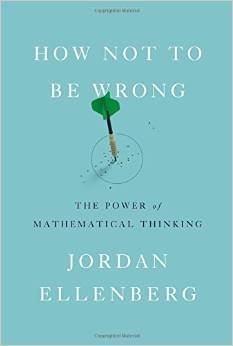 Ellenberg, Jordan. 2014. How Not to Be Wrong: The Power of Mathematical Thinking. Penguin. ****
Ellenberg, Jordan. 2014. How Not to Be Wrong: The Power of Mathematical Thinking. Penguin. ****
How to apply mathematical concepts to everyday situations that are often misunderstood by ordinary “common sense.” Among the many topics: the dangers of simple linear relationships, simplistic trend extrapolations, and proportions (with examples of political claims that illustrate these); the dangers of inference (improbable things happen a lot, in large enough samples); limits of prediction in chaotic situations; how to apply Bayesian inference (e.g. applied to the creation of the universe); the idea of expected values; balance of cost vs. convenience; the flaw of Pascal’s Wager; regression and correlation (it’s not always wrong to be wrong — you can’t wait for perfect evidence to make a decision); problems with opinion polls; various voting methods; and conflicts between what is true and what is right, when no new evidence is allowed. How to be right: try to prove your theorem by day, disprove it by night, and apply to all areas of life. A valuable complement to books about rhetoric and mental biases. [part 1; part 2; part 3]
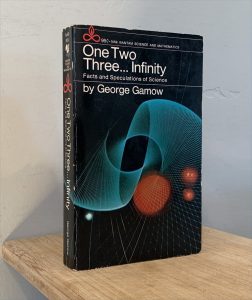 Gamow, George. 1961. One, Two, Three…Infinity. Bantam. *****
Gamow, George. 1961. One, Two, Three…Infinity. Bantam. *****
First published 70 years ago, this is dated now of course, lacking 70 years of advancements in all the sciences since it was first published. But in its time this was one of the best popular science books ever written, covering the basics of numbers, space and time, chemistry and biology, astronomy and cosmology. Personally, when I read this at age 14, I was especially impressed by the sections about infinities, and the history of how humans, step by step, discovered the size and shape of the Earth, the solar system, the stars, the galaxies. My copy shown here is the 1967 Bantam edition. (post)
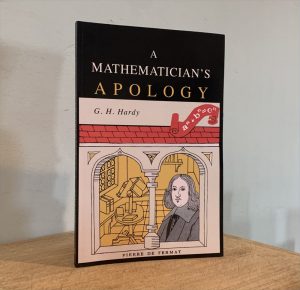 Hardy, G. H.. 2018. A Mathematician’s Apology. Martino. ***
Hardy, G. H.. 2018. A Mathematician’s Apology. Martino. ***
The book shown is a new edition of a famous essay first published in 1940. Hardy “apologizes” for the notion that mathematics is a field of study worthy of a grown man’s career — considering how most of it (except for that which powers science and engineering) — is useless. As an aside he says that people who write popularizations of science for the public are lesser minds than true scientists and mathematicians; this may have been true in his day (Asimov and even Sagan were so dismissed by some), but less so these days with Wilson, Pinker, or Greene. His two big questions: is math worth doing? And why study it in any case? One defense is that math is permanent; a discovery in math remains true forever. Further, ideas in math should be both serious, and beautiful (in contrast to chess, say, which is unimportant). He gives examples of first rate mathematical theorems (concerning prime numbers and the square root of two), contrasts pure and applied math, and wonders whether math exists independently of our minds. And personally, he discovered math early on, and never wanted to do anything else, and feels he’s led a worthy life. (post)
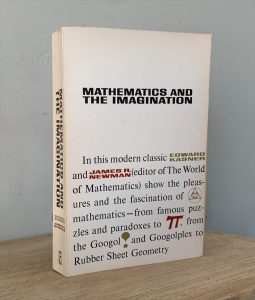 Kasner, Edward, & Newman, James. 1967. Mathematics and the Imagination. Fireside/Simon & Schuster. *****
Kasner, Edward, & Newman, James. 1967. Mathematics and the Imagination. Fireside/Simon & Schuster. *****
An introduction to mathematical themes for the lay reader, including infinities, topologies, non-Euclidean geometries, chance and probablities, transcendental numbers. Also fun topics like puzzles and paradoxes, which can be understood with mathematical insight. Concludes by pondering the philosophical question of whether math is discovered, or invented, by humans; they come down on the latter, with non-Euclidean geometries as an example. But the book was published 80 years ago, and things may have changed. (Originally published 1940.) (post)
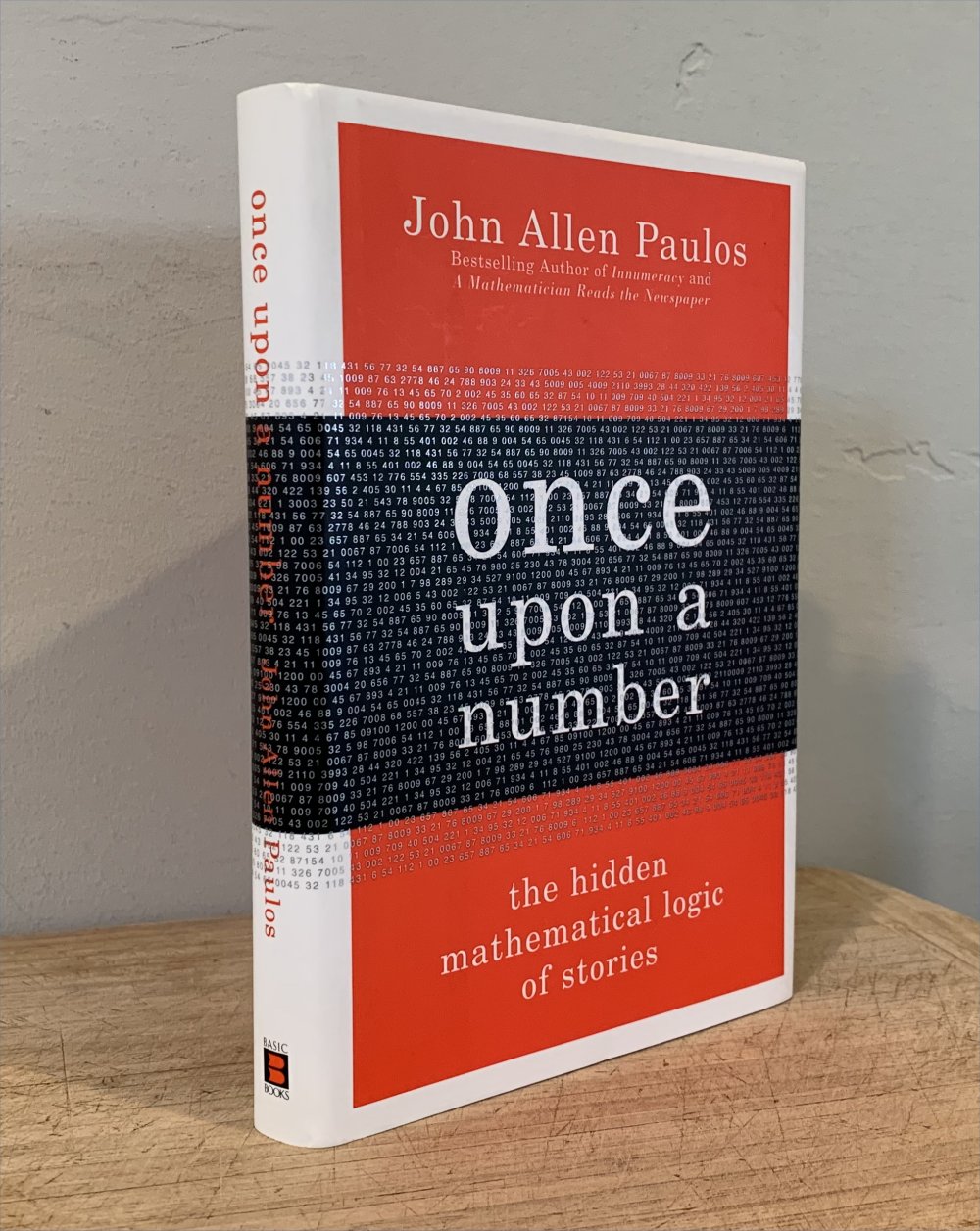 Paulos, John Allen. 1998. Once Upon a Number: The Hidden Mathematical Logic of Stories. Basic Books. ***
Paulos, John Allen. 1998. Once Upon a Number: The Hidden Mathematical Logic of Stories. Basic Books. ***
Paulos compares and contrasts the ideas of narrative and statistics, how some things are best understood one way or the other, and how humans have a way of confusing the two. As in Paulos’ other books, general themes are illustrated with copious examples and anecdotes. Themes are stories vs. statistics; subjective viewpoint vs. impersonal probability; informal discourse and logic; meaning and information. Examples include surveys conducted with ideological axes to grind; a rabbi who introduces only subjects for which he has parables; how news focuses on anecdotes which can be deceptive and distort public policy; how we rationalize coincidences (Bible Code, sex scandals); a parable about furious feminists in a village with philandering husbands. How in any sufficiently large set of elements, unlikely things will occur. Beware category mistakes — don’t elevate personal details into grandiose movements. Example of Princess Diana: was her demise just circumstances, or the result of a sordid soap opera? Religion is about stories; science tends to diminish the personal. They can coexist if we avoid simple-minded attempts to reduce one to the other. (post)
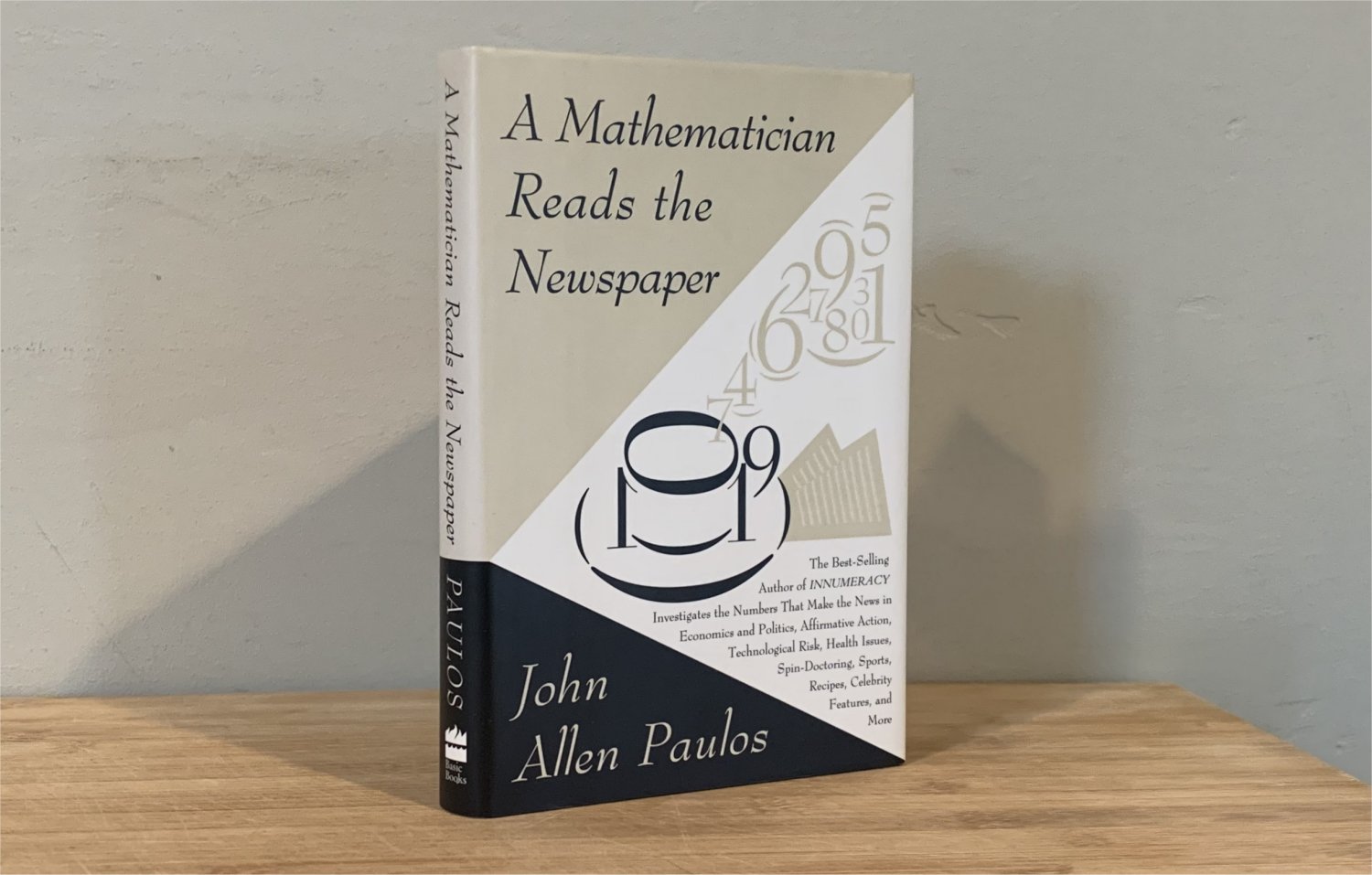 Paulos, John Allen. 1995. A Mathematician Reads the Newspaper. Basic. ***
Paulos, John Allen. 1995. A Mathematician Reads the Newspaper. Basic. ***
A sequel to Innumeracy, this is a survey of the many topics one finds in newspapers that can be better understood with insights from mathematics, as well as from psychology, including the predisposition of humans to turn everything into stories. Topics include politics (voting schemes, psychological biases, equivocation, coincidences); social issues (gun control, abortion, stock market patterns, lawsuits, advertising); lifestyle issues (celebrity profiles, perceiving trends that don’t exist); science and medicine (clarity vs precision, why reporting is credulous about supernatural claims, category errors); food, fashion, and sports (nutrition info, sports records, top 10 lists, how religious coverage avoids mentioning the absence of evidence for beliefs, obituaries). Always be smart; seldom be certain. (post)
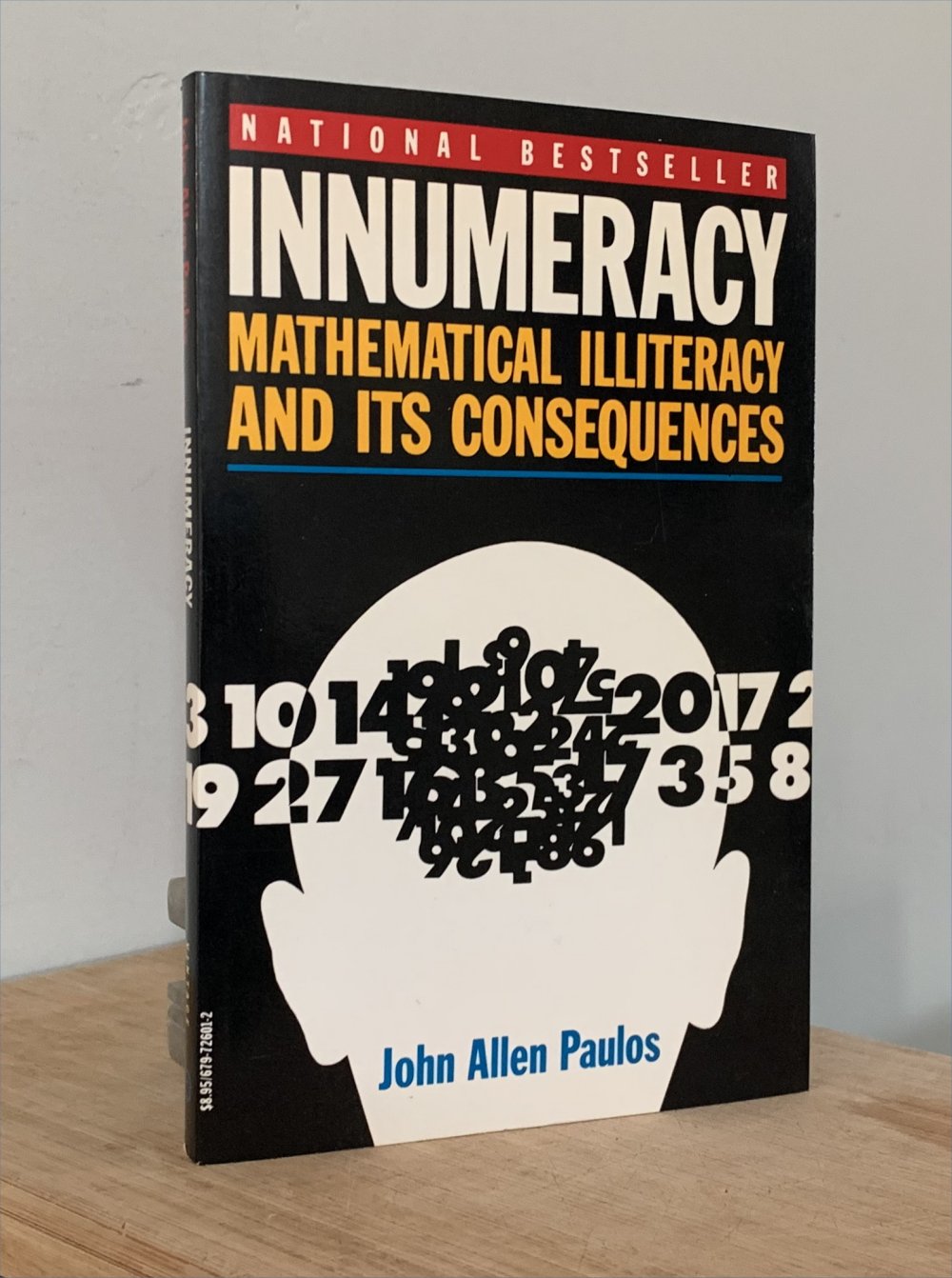 Paulos, John Allen. 1990. Innumeracy: Mathematical Illiteracy and Its Consequences. Vintage. *** 1/2
Paulos, John Allen. 1990. Innumeracy: Mathematical Illiteracy and Its Consequences. Vintage. *** 1/2
The first of several by this author about applying mathematical concepts in every day life, and the harm in not being able to do so. Examples, among many, include not understanding the difference between a million and a billion, the persistence of pseudosciences like astrology, and the underappreciation of coincidences and other randomness in every day life. Numeracy involves understanding the news media’s bias toward coincidences, assessing probability usefully (e.g. dying by terrorist attack v dying by slipping in the bathtub), understanding the nature of voting methods, type I and type II errors, and random samples. Above all the author emphasizes “the irreducibly probabilistic nature of life,” appreciating which is a mark of maturity and balance. (post)
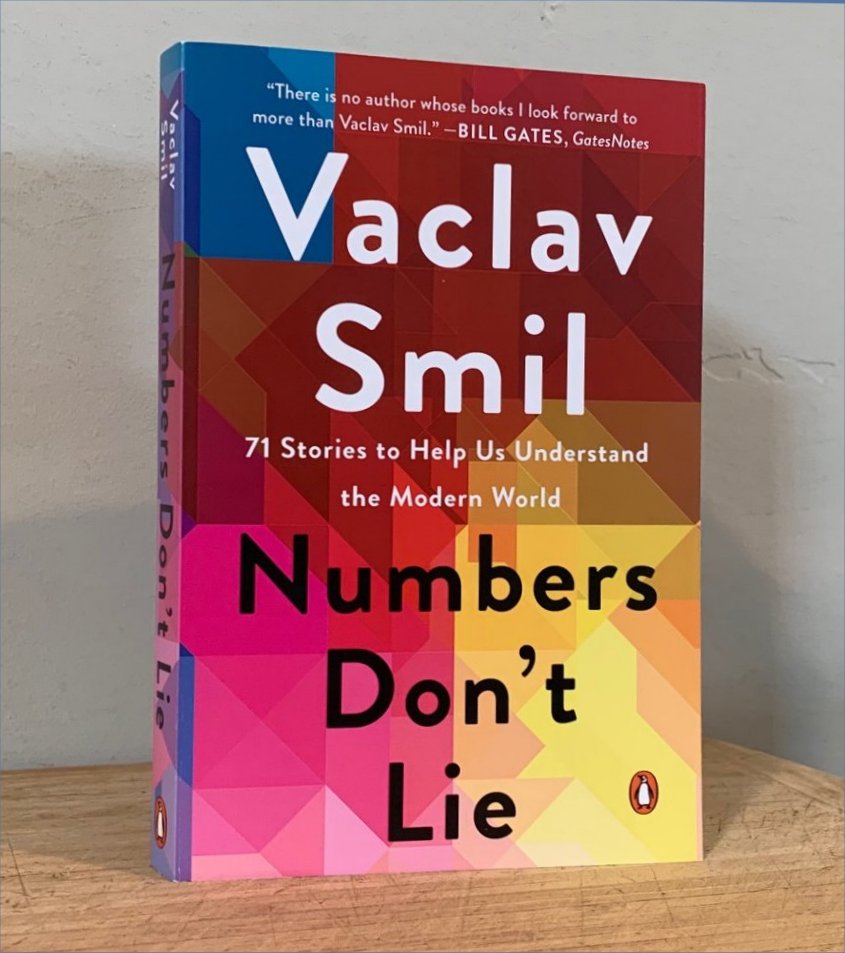 Smil, Vaclav. 2021. Numbers Don’t Lie: 71 Stories to Help Us Understand the Modern World. Penguin Books. ** 1/2
Smil, Vaclav. 2021. Numbers Don’t Lie: 71 Stories to Help Us Understand the Modern World. Penguin Books. ** 1/2
A collection of 71 magazine essays (from IEEE Spectrum) about how to understand the world quantitatively. Topics range from quality of life (best indicator: infant mortality), return on investment for public health (vaccination), what makes people happy (being rich, or poor and Catholic), and whether the US is exceptional (considering infant mortality, lack of universal healthcare, etc: no). A recurring, troubling theme is how dependent our infrastructure is on fossil fuels; it won’t be as easy to get off them as some think. But key themes are taking care to use properly sourced data, and to properly compare data, e.g. when comparing budgets of nations, use the same metrics and appropriate conversion rates to assess them. (He does not mention the internet.) Numbers may not lie, but they must be understood in context; beware ranking that can be misleading, unnecessary precision, and so on. (post)
 Ellenberg, Jordan. 2014. How Not to Be Wrong: The Power of Mathematical Thinking. New York: Penguin. ****
Ellenberg, Jordan. 2014. How Not to Be Wrong: The Power of Mathematical Thinking. New York: Penguin. ****
How to apply mathematical concepts to everyday situations that are often misunderstood by ordinary “common sense.” Among the many topics: the dangers of simple linear relationships, simplistic trend extrapolations, and proportions (with examples of political claims that illustrate these); the dangers of inference (improbable things happen a lot, in large enough samples); limits of prediction in chaotic situations; how to apply Bayesian inference (e.g. applied to the creation of the universe); the idea of expected values; balance of cost vs. convenience; the flaw of Pascal’s Wager; regression and correlation (it’s not always wrong to be wrong — you can’t wait for perfect evidence to make a decision); problems with opinion polls; various voting methods; and conflicts between what is true and what is right, when no new evidence is allowed. How to be right: try to prove your theorem by day, disprove it by night, and apply to all areas of life. A valuable complement to books about rhetoric and mental biases. [part 1; part 2; part 3]
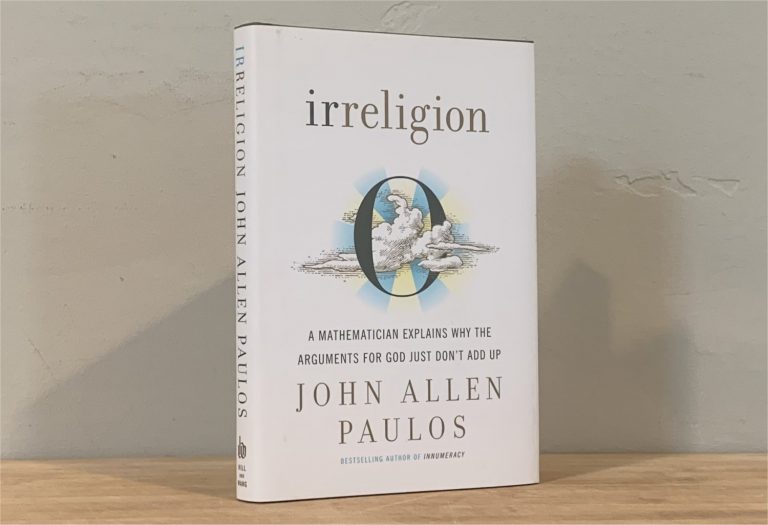 Paulos, John Allen. 2008. Irreligion: A Mathematician Explains Why the Arguments for God Just Don’t Add Up. Farrar, Straus and Giroux/Hill and Wang. ***
Paulos, John Allen. 2008. Irreligion: A Mathematician Explains Why the Arguments for God Just Don’t Add Up. Farrar, Straus and Giroux/Hill and Wang. ***
A slender and breezy book by a mathematician, dismantling the common arguments for the existence of God. The four classical arguments (first cause, design, anthropic principle, ontology) on grounds of logical incoherence and/or statistical implausibility; subjective arguments (coincidence, prophecy, subjectivity, interventions) on statistical grounds; and four psycho-mathematical arguments (redefinition, cognitive tendency, universality, and gambling). With asides about a personal pseudoscience, recursion, emotional need, Jesus and CS Lewis, a dream conversation with God, and the idea of “brights.” (Notes)
 Paulos, John Allen. 1998. Once Upon a Number: The Hidden Mathematical Logic of Stories. Basic Books. ***
Paulos, John Allen. 1998. Once Upon a Number: The Hidden Mathematical Logic of Stories. Basic Books. ***
Paulos compares and contrasts the ideas of narrative and statistics, how some things are best understood one way or the other, and how humans have a way of confusing the two. As in Paulos’ other books, general themes are illustrated with copious examples and anecdotes. Themes are stories vs. statistics; subjective viewpoint vs. impersonal probability; informal discourse and logic; meaning and information. Examples include surveys conducted with ideological axes to grind; a rabbi who introduces only subjects for which he has parables; how news focuses on anecdotes which can be deceptive and distort public policy; how we rationalize coincidences (Bible Code, sex scandals); a parable about furious feminists in a village with philandering husbands. How in any sufficiently large set of elements, unlikely things will occur. Beware category mistakes — don’t elevate personal details into grandiose movements. Example of Princess Diana: was her demise just circumstances, or the result of a sordid soap opera? Religion is about stories; science tends to diminish the personal. They can coexist if we avoid simple-minded attempts to reduce one to the other. (summary)
 Paulos, John Allen. 1995. A Mathematician Reads the Newspaper. Basic Books. ***
Paulos, John Allen. 1995. A Mathematician Reads the Newspaper. Basic Books. ***
A sequel to Innumeracy, this is a survey of the many topics one finds in newspapers that can be better understood with insights from mathematics, as well as from psychology, including the predisposition of humans to turn everything into stories. Topics include politics (voting schemes, psychological biases, equivocation, coincidences); social issues (gun control, abortion, stock market patterns, lawsuits, advertising); lifestyle issues (celebrity profiles, perceiving trends that don’t exist); science and medicine (clarity vs precision, why reporting is credulous about supernatural claims, category errors); food, fashion, and sports (nutrition info, sports records, top 10 lists, how religious coverage avoids mentioning the absence of evidence for beliefs, obituaries). Always be smart; seldom be certain. (Notes)
 Paulos, John Allen. 1988. Innumeracy: Mathematical Illiteracy and Its Consequences. Hill & Wang (Vintage 1990). ***1/2
Paulos, John Allen. 1988. Innumeracy: Mathematical Illiteracy and Its Consequences. Hill & Wang (Vintage 1990). ***1/2
The first of several by this author about applying mathematical concepts in every day life, and the harm in not being able to do so. Examples, among many, include not understanding the difference between a million and a billion, the persistence of pseudosciences like astrology, and the under-appreciation of coincidences and other randomness in every day life. Numeracy involves understanding the news media’s bias toward coincidences, assessing probability usefully (e.g. dying by terrorist attack v dying by slipping in the bathtub), understanding the nature of voting methods, type I and type II errors, and random samples. Above all the author emphasizes “the irreducibly probabilistic nature of life,” appreciating which is a mark of maturity and balance. (summary)
 Gamow, George. 1947/1961. One Two Three… Infinity. [This edition Bantam, 1967]. *****
Gamow, George. 1947/1961. One Two Three… Infinity. [This edition Bantam, 1967]. *****
First published 70 years ago, this is dated now of course, lacking 70 years of advancements in all the sciences since it was first published. But in its time this was one of the best popular science books ever written, covering the basics of numbers, space and time, chemistry and biology, astronomy and cosmology. Personally, when I read this at age 14, I was especially impressed by the sections about infinities, and the history of how humans, step by step, discovered the size and shape of the Earth, the solar system, the stars, the galaxies. (summary)
 Kasner, Edward, & James R. Newman. 1940. Mathematics and the Imagination. Simon & Schuster [This edition 1967]. *****
Kasner, Edward, & James R. Newman. 1940. Mathematics and the Imagination. Simon & Schuster [This edition 1967]. *****
An introduction to mathematical themes for the lay reader, including infinities, topologies, non-Euclidean geometries, chance and probabilities, transcendental numbers. Also fun topics like puzzles and paradoxes, which can be understood with mathematical insight. Concludes by pondering the philosophical question of whether math is discovered, or invented, by humans; they come down on the latter, with non-Euclidean geometries as an example. But the book was published 80 years ago, and things may have changed.
(summary)





